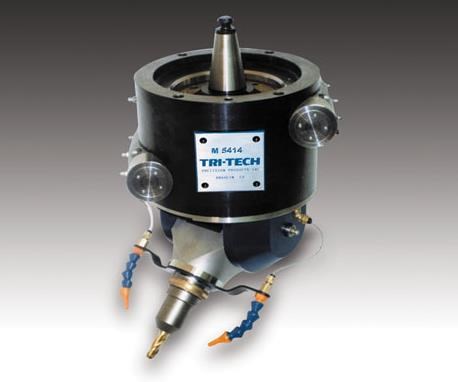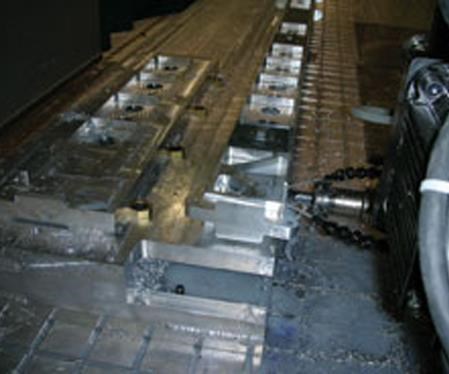Adding 5-Axis Capability to a 3-Axis CNC Mill
This attachment provides shops using thee-axis machining centers the option of on-demand four- and five-axis machining.
If all metalworking parts needed five-axis machining capability, then all machining centers would be five-axis machines. However, the fact is, for most shops, many workpieces only need the linear XYZ motion of three-axis machining.
But for those parts that have angular features, complex contours or feature access issues beyond a three-axis machine’s effective work envelope, wouldn’t it be nice if a relatively inexpensive system could quickly and easily convert a three-axis horizontal or vertical machining center into an “on-demand” five-axis machine? That’s the idea behind the five-axis programmable head attachment available from Tri-Tech Precision Products.
Featured Content
Fill a Need
As is so often the case in our industry, necessity breeds innovation. Tri-Tech’s origin is as a high precision, prototype, NC machine shop, established in 1989. In the early 1990s the shop, with a stable of three-axis NC machining centers, found increasing opportunities to bid five-axis aerospace work, but was forced to either no-bid the job or to spend large amounts of time on programming and multiple setups in order to simulate five-axis capabilities. Such jury-rigged solutions were expensive then and, with tolerance demands as well as single part handling goals, are almost out of the question today.
With the need for five-axis capability identified, but with an unwillingness to invest in dedicated five-axis machines or sacrifice worktable space with A/B tilt-rotary tables, in 1994 Tri-Tech designed and developed a programmable two-axis spindle head for attachment to its existing three-axis NC machining centers. The portable head attachment, together with their own three-axis machines, gave them full five-axis machining capability, and it worked. The shop soon found that the increased capability of its programmable head allowed bidding and winning more technical, complex and higher profit margin jobs.
The shop found that, because the unit was portable and installed in less than 30 minutes, they could machine features of a given workpiece in three axes, then install the head for any five-axis machining as necessary. Moreover, the unit could, on any of the shop’s three-axis machines, be passed around the shop when an application called for additional machining capability.
Spread the Word
With its in-house success, Tri-Tech soon saw the market potential of its new invention and wanted to produce a commercial version of the device for attachment to any three-axis CNC machine, thus providing five-axis capability at a fraction of the cost of a traditional five-axis machining center. The first production model debuted at Westec in March 1997, where its initial production run of four units sold out immediately after the show. It was a good beginning.
Every year since has seen another model and significant enhancements including improved spindle designs, integrated coolant, increased precision worm and bevel gears. Enhancements provide increased strength and rigidity while improving accuracy through both mechanics and software calibration.
The Latest Version
Tri-Tech’s current offering is its Model 5414, dubbed “five-axis in a box.” It features its most rigid spindle design to date and is available with a two-axis controller that allows CNC mills, without a five-axis capable control, to do 3+2 positioning for drilling and slotting.
For machining centers with five-axis-capable CNCs, the new five-axis head attaches to virtually any three-axis vertical, horizontal or bridge-style machining center and will provide true simultaneous five-axis machining and drilling capability. Its attachment point is the host machine’s spindle using a standard V-taper flange.
The host machine’s spindle drive transfers directly rotational to the tool at a ratio of 1-to-1 so none of the machine’s standard spindle speed is sacrificed. This portable head attachment is designed to handle the most complex machining including full five-axis profiling, contouring, slots and holes.
Weighing in at 150 pounds, the unit includes a holding fixture enabling a quick installation time of less than 30 minutes. The head attachment is machined from a solid billet and uses A2 tool steel in the drive block and main bevel gears. The spindle and worm gear housing is 17-4 stainless steel, resulting in a heavy-duty solid steel attachment that is sturdy enough to adapt to very large machining centers, yet compact enough to attach to many smaller and mid-size machines.
Machine tool independence allows users to adapt the M5414HS to several CNC machines, which expands a company’s five-axis capability throughout the shop floor without additional cost. The 5414’s tilt range of ± 90 degrees and continuous 360-degree rotation capability competes with all but the most expensive five-axis machining centers with no unwinding required. Rapid tool change for the unit is provided through a dual-contact HSK tooling system.
Success So Far
Simultaneous five-axis requirements include any five-axis capable CNC controller and a five-axis post processor available through Tri-Tech Precision Products. The company’s model 5414 has been adapted to various small to large-sized CNC machines including Fadal, Mighty, Haas, Hurco, Milltronics, Matsura and YCI vertical milling centers; Lucas and Wotan horizontals; Giddings & Lewis, Okuma and Mighty Bridge machines and Cincinnati V20. With the addition of the newly available two-axis control unit, virtually any three-axis machining center can at least perform 3+2 positioning on larger parts for shops without a five-axis control capable machining center.
The attachment’s compact design, solid steel construction and portability allow machine shops to take advantage of advanced multi-axis technology while protecting their investment in existing machine tools. The two-axis control adds even more flexibility for users without a five-axis controlled machine.
RELATED CONTENT
-
Okuma’s OSP Control is 50 Years Old
In 1963, Okuma introduced its first CNC the OSP. OSP stands for Okuma sampling path, which emphasized the innovation of creating a digital representation of a machine tool’s cutting path.
-
Monitoring Perishable Tools On Automatics
Monitoring tool wear is an essential component to getting greater productivity and lower costs from a machine tool.
-
Manufacturing Automation Beyond Robots at PMTS
A variety of automated machining and manufacturing processes — including, but not limited to, robotics — that can enable shops to become more efficient were on display at the recent Precision Machining Technology Show.









